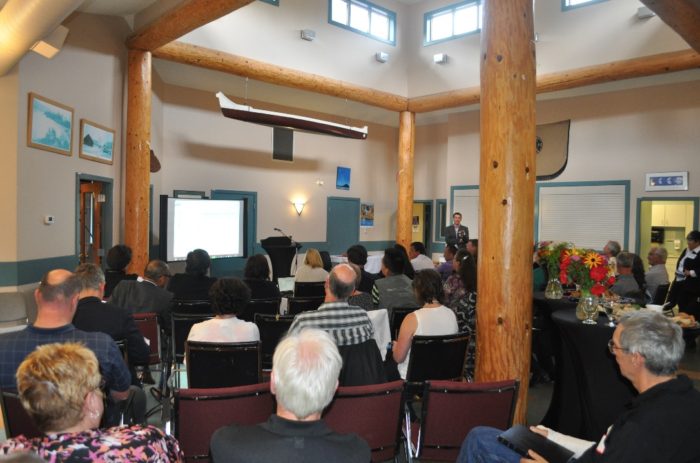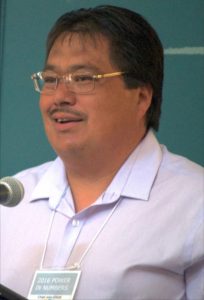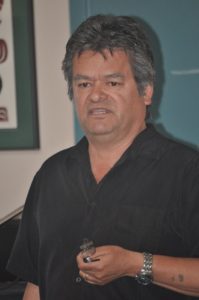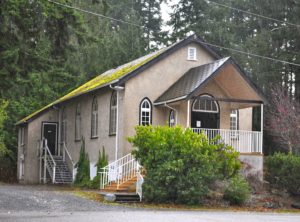Relationships are key
The annual Power in Numbers event at Stz’uminus on June 23 heard some straight talking from First Nation leaders as they spoke about sharing, relationships and sustainability.
People from industry and government filled the elders centre for the networking event. Many hands were shaken and contacts exchanged – Chief John Elliott even remarked about “all the money in the room” – as the audience heard about major new developments at Stz’uminus.
“It’s been a roller coaster ride, but it has been fun creating partnerships and relationships,” said Chief Elliott. He spoke about the new credit union branch being built with a Tim Hortons/Esso gas station and a Microtel hotel in the first phase of the Oyster Bay project on the Trans Canada Highway.
“We can create an economy and jobs, not only for the Stz’uminus people, but for everyone,” he said of the new community that will have hundreds of homes and assisted living units.
“This is helping us become a self-sufficient nation,” he said. “We’ll be able to make our own choices and make our own decisions… Stz’uminus is open for business; that’s why we’re here today.
“We want to live where everyone is treated fairly and not living in third-world conditions in their own rich country,” Chief Elliott said. “We have to help each other. We want to share with you and grow with you.”
Among the people from resource companies and government agencies in the room, the chief singled out the mayor and council of the nearby town of Ladysmith for fostering good relationships and partnerships.
“They have always been there, always supporting us,” he said. “They are not just about talking with us, but walking with us.”
Big profits forecast for Ladysmith project
Stz’uminus First Nation and its development partner are one step closer to building a new neighbourhood in Ladysmith.
A bylaw that will make way for its long-awaited Holland Creek project passed third reading by the town’s council in late June. The proposal is to build 600 residential units on about 57 hectares of land on Ladysmith’s perimeter, effectively expanding the town.
The third reading came as the nation began construction on Oyster Bay, a separate development it is building on reserve lands along the Trans Canada Highway.
It has taken Stz’uminus several years to finalize the town’s approval for the development. Construction was initially slated to begin in late 2014.
But Ray Gauthier of Coast Salish Development Corporation – the nation’s economic development arm – said that while the project has not formally been given a final stamp of approval, it’s almost there.
“We were having trouble moving it through the town,” he said. “But this is sort of the benchmark of a done deal.”
He said the project will be huge for the nation in terms of profit – he expects it could bring in about $40-million over 10 years.
Chief Planes looks to the T’Sou-ke future
A culture of sharing and sustainability was the theme for Chief Gordon Planes in his talk at the gathering.
“I was in Greenland recently, of all places, speaking at a university. We had discussions about adaptation to climate change and sustainability. Those kinds of discussions have to happen here as well, on Vancouver Island.
“We are not the salmon people without salmon,” he said.
“We are thinking ahead 100 years… about what kind of legacy are we going to leave for the children not born yet.”
T’Sou-ke has been a leader in Canada when it comes to producing solar power, food sustainability and reviving the culture because the community is always asking “How can we lessen our footprint?” and how to make the world a better place, Planes said.
“We’re looking forward to the future,” he said. “We’re part of the change. We don’t know where that change is going to bring us, but we’re excited where we are right now.”
The reason homes and offices at T’Sou-ke are powered by the sun, or greenhouses grow food and commercial crops, or five million oysters are growing in Sooke Basin isn’t for monetary reasons, Planes said.
“We didn’t do it to make money. We did it for our children.”
That’s also the reason the community is re-learning its language and bringing back the culture. As an example, he talked about the old church building that was returned to T’Sou-ke two years ago.
“We still use it as a church, but also as a place to bring our culture back.
“It’s actually come full circle. At one time the church was built there to get rid of our culture. Now we’re using it to bring it back. And that’s pretty cool.”







